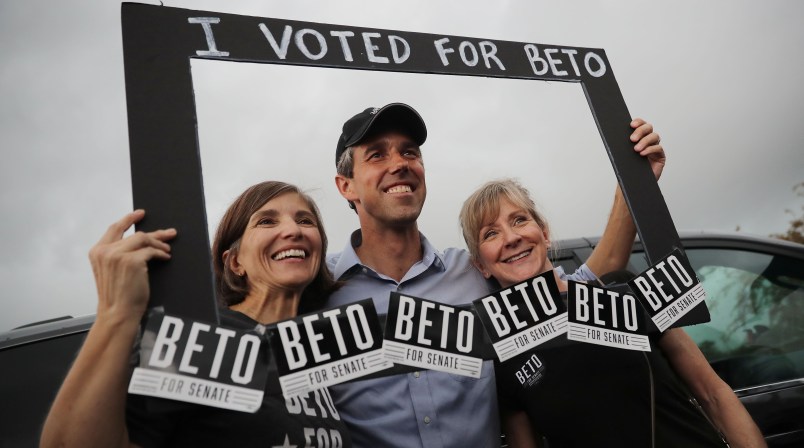Texas voters are turning out at huge rates that look a lot more like the last presidential contest than recent midterms. Could this be good news for Rep. Beto O’Rourke (D-TX) in his difficult quest to defeat Sen. Ted Cruz (R-TX)?
Democratic strategists think there are some positive signs that interest in O’Rourke’s campaign and the white-hot intensity of voters of all stripes is giving him an outside chance to pull off an upset. That includes some who have been skeptical of his chances for much of the campaign. But Republicans – including serious modelers analyzing the data — remain skeptical.
Early vote analysis doesn’t tell us how people are voting, just who’s showing up, and it’s been notoriously difficult to game out what early vote numbers say about what the final result of an election may show. But that doesn’t mean there isn’t information to glean about the electorate.
Here’s what we do know. More voters have already cast their ballots in Texas than they did in the entirety of the 2014 early vote. The early vote population is also significantly younger and a bit more diverse than it was four years ago, when Texas Gov. Greg Abbott (R) won in a 20-point landslide.
But O’Rourke has trailed Cruz in recent public and private polling by anywhere from three to eight points. If he’s going to somehow pull off a win — still an unlikely scenario but not an impossible one — he’s going to need both to fundamentally reshape the electorate from past elections and handily win independents.
“If the electorate looks like these polls look like no, Beto doesn’t have a chance. But the early vote does give you reason for optimism in terms of the electorate looking pretty dramatically different in Texas,” Democratic modeling expert Tom Bonier, who is doing some consulting for the Texas Democratic Party, told TPM on Wednesday. “My instinct on that is the polls are overly conservative in terms of the composition of the electorate and you’re looking at a margin of error race.”
According to Bonier’s model, at this point in the early vote in 2014 people 65 or older had cast 47 percent of the ballots. This time around, it’s down to 34 percent. The percentage of the early vote cast by voters under 40 has climbed from just 11 percent in 2014 to 21 percent now.
The early vote electorate also appears to be a bit more diverse this time around, according to Bonier’s model. But while non-Anglo (Non-Hispanic white) voters are turning out at much higher rates than in the past and the uptick in their rate of voting has increased more than with Anglo voters, Anglo whites continue to make up a large part of the electorate. In 2014, the early vote electorate at this point was about 75 percent Anglo, 13 percent Hispanic and 6 percent African American. As of now it’s 73 percent Anglo, over 15 percent Hispanic and almost 7 percent African American.
That’s a shift, but not a huge one.
In the model there are still 1.9 million predicted early GOP voters, and just 1.35 million predicted early Democratic voters.
Chris Wilson, a GOP modeling expert who is working for the Cruz campaign, said he didn’t think the model itself was far off, though he declined to discuss his own model on record. But he strongly disagreed with Bonier’s read on what those numbers meant.
“It is a very optimistic, blue-colored glasses reading of the data, and to me I think it shows exactly what I’m expecting: Sen. Cruz is winning and will win on Tuesday,” he said.
But surging turnout in the state as well as anecdotal but repeated evidence of O’Rourke’s crossover appeal in some surprising corners of Texas makes this a tricky electorate to predict. There were just 4.7 million total votes cast in the 2014 midterms, the nadir of turnout and a complete Democratic wipeout in the state. In 2016, about 9 million people voted for president. Right now, if election-day voting continues the current surge (and early voting hasn’t cannibalized that many voters who would have voted anyways), strategists think turnout could be on pace to crack 6.5 million people in the state, and potentially climb as high as 7 million. That could lead to some surprising results.










